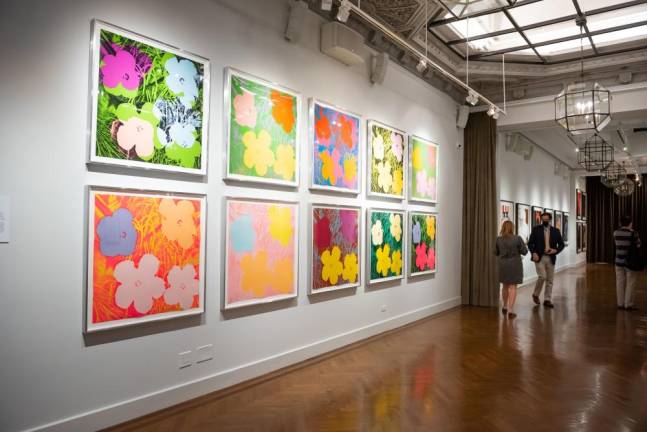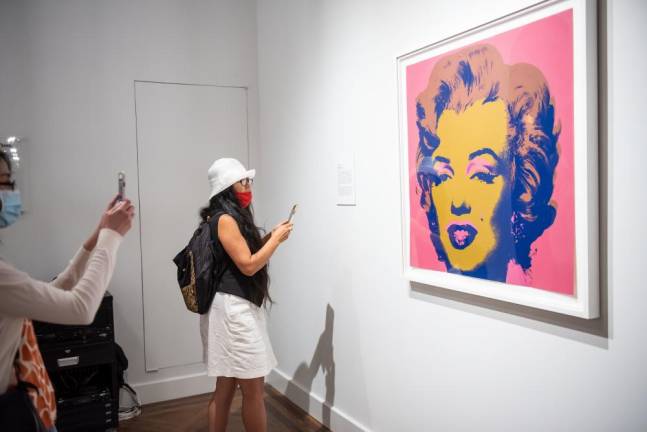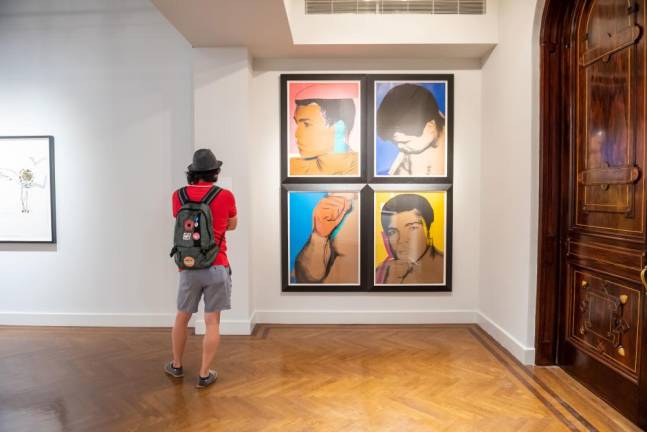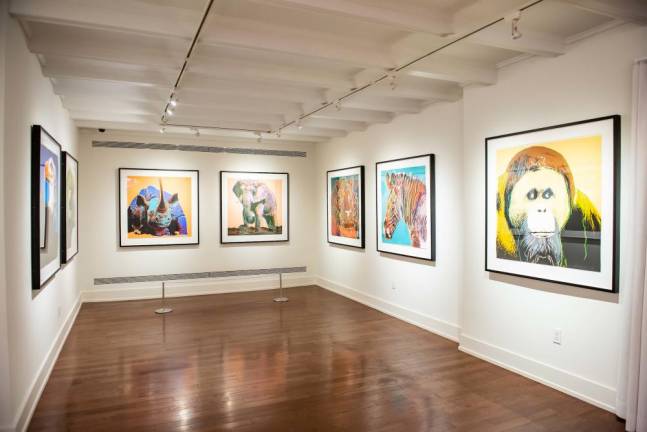The Other Prince of Pop: Andy Warhol
A show of the iconic artist’s photographic printmaking at the National Arts Club ranges from soup cans to endangered species




The Andy Warhol Show at the National Arts Club is a rare opportunity to explore a particular technique of the founder of Pop Art - photographic silkscreen printmaking – and how he combined his vibrant color sense and artistic instincts with commercial smarts ... and in one series, a poignant self-awareness.
The show (which runs through 11/4 and is sponsored by Bank of America), announces this at the very outset with Warhol’s own words: “Business art is the step that comes after Art. I started as a commercial artist, and I want to finish as a business artist. After I did the thing called ‘art’ or whatever it’s called, I went into business art. I wanted to be an Art businessman or a Business Artist. Being good in business is the most fascinating kind of art.”
The subjects here span the ridiculous (the soup can lineup) and the sublime (a series of portraits of endangered species), the iconic (his Myths series) and the quotidian (flowers and sunsets).
What they share is an exuberant use of color and texture (the Myth series uses “diamond dust”), and special effects like double images and contrasting outlines to emphasis outlines and make them ... Pop. (Maybe that’s really where the term came from.)
The show opens with the image that made Warhol’s career: Marilyn Monroe, with Muhammed Ali across the room, and leads visitors to two simply beautiful sets of images: “Flowers” and “Sunsets.”
An Homage to Matisse?
Warhol infuses these works with liveliness. The Flowers series has a distinct Matisse-ian air; the roughly outlined blooms look like the paper cutouts Matisse favored in his later years, with an effervescent color sense he also would have appreciated. The exhibit wall panel explains that Warhol was deeply interested in color, with a personal library packed with volumes on great modern colorists like Matisse and Pierre Bonnard. The series has an amazing variety, even though they feature the same blooms and the same backgrounds – all purely through color.
The same dynamic informs the “Sunset” series, even more dramatically, in a way that defines Warhol’s self-image as a Business Artist. Here he uses the same process as Henry Ford – standardized “equipment” and techniques – to “manufacture” art. With just three elements: the sun image, the background bands, and a single color dot pattern, Warhol created 632 images, using only color to differentiate each one. Ford would have been proud ... except Ford preferred to work only in black.
The Softer Side of Andy
The most touching, even poignant display is the Myths series. Many have suggested that all ten of these images from pop culture reflect different aspects of Warhol’s personality. If so, that makes a touching (although sometimes politically incorrect) display: Dracula, Howdy Doody, Mammy, Mickey Mouse, Santa Claus, Superman, The Star (Greta Garbo), The Witch (Margaret Hamilton from the Wizard of Oz), Uncle Sam, and finally himself as The Shadow.
This mashup of archetypes – childhood characters, villains, nurturers, vamps and heroes – all pop and sizzle with color, line...and bling. Santa twinkles from a background of ‘diamond dust,” Dracula glowers in a sea of darkness, and Howdy Doody looks blankly from a garish display of riotous carnival colors. Warhol’s own image – the Shadow – uses only shades of grey with no diamond dust, a surprisingly sedate exception.
Compared to this, the kick line of soup cans on the facing wall doesn’t stand a chance.
Endangered species
Downstairs, the exhibit continues with a small display of prints using Vesuvius as the dominant image ... but the show-stopper is the Endangered Species series that dominates the room.
Warhol was a dedicated animal lover (his will specified funds for environmental conservation; he once said “I never met an animal I didn’t like”). These ten beautiful prints convey Warhol’s attitudes towards the animals as well as something he saw innately in the animals themselves.
Working with pictures from magazines and newspapers, he made photographic silkscreen prints of ten endangered animals: the African Elephant, the Bald Eagle, the Bighorn Ram, the Black Rhino, the Giant Panda, Grevy’s Zebra, the Orangutan, the Pine Barrens Tree Frog, the San Francisco Silverspot and the Siberian Tiger. The bald eagle looks heroic, naturally, but it’s a mark of Warhol’s genius that he could use color and outline to make a panda look cuddly yet vulnerable, a tree frog look defiant, an orangutan look quizzical and a tiger look even more exotic. The colors pop and fizz with contrasting colors and multiple outlines. The impression is exhilarating.
Parting Shot by a Fellow Artist
Compared to his self-revelatory Myths series and the vibrant yet tender love for animals in Warhol’s Endangered Species series, the next room seems ... petty. Keith Haring, no slouch as a successful artist himself, gave a backhanded compliment to Warhol in the four works in the next room. Each work features Warhol as a Mickey Mouse-like figure reimagined with the trademark white hair and dark glasses. In each one, he’s standing in piles of greenbacks, or wearing greenbacks on his body, or being carried by androgynous figures above a pile of greenbacks. While Warhol himself admitted/confessed to wanting to be a Business Artist, it seems churlish to depict him this way. As the Endangered Specials series just one room away proves, Warhol wasn’t always interested in it just for the money.